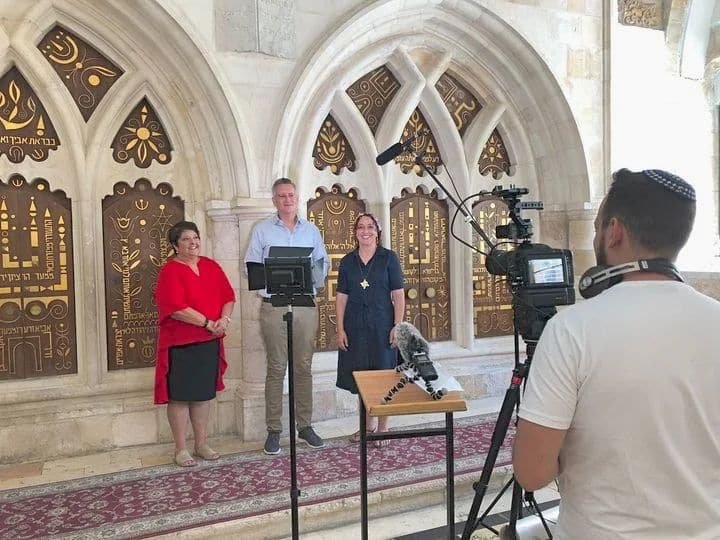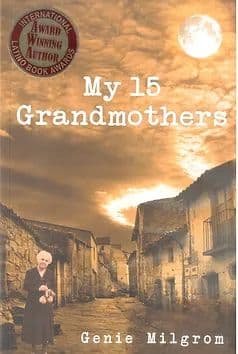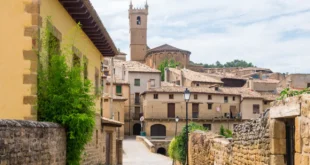
Left to right: Genealogist Genie Milgrom, Ashley Perry (Perez), president of Reconectar, and Dr. Drora Arussy of the Institute of the Jewish Experience at the American Sephardi federation during an event at the Four Synagogue in Jerusalem in August (Courtesy Genie Milgrom).
Genie Milgrom has an ambitious goal: to load up thousands of little-known documents of Jewish life in Spain and Portugal prior in those countries on her website.
One of them, dated 1251, is a receipt in which two Jews, David Pimentero and Samuel Rosell, acknowledge receiving the eighteenth payment of fifty owed to them by Martí Palau and his wife, Elisenda, of the parish of Santa Eulalia de Provencana, in Barcelona.
“That’s pure history and I have thousands such documents,” said Milgrom during a recent talk titled “Los Archivos de la Inquisición—Nuevas Fuentes Disponibles” (The Inquisition Archives —New Available Sources) on e-Sefarad, the leading site on the Internet devoted to Sephardic culture. “Those are tidbits of Jewish history before the Inquisition, of which we know little, and that’s the thread to connect with the Jewish people.”
The Inquisition was established in Spain in 1478 by the Catholic Monarchs, King Ferdinand II of Aragón and Queen Isabells I of Castile. It was established in Portugal in 1536.
A limpieza de sangre (purity of blood) document also obtained by Milgrom, dated 1522, banned Jews and Moors and their descendants from serving in any ecclesiastical capacity “forever and ever” in the cathedrals of Jaén or Baeza, in southern Spain.
She approached several companies and institutions in Israel to have the documents digitized, but they showed no interest. “Nobody sees their value,” she said.
Thus, she took it upon herself to digitizing them and has spent many long hours at her computer entering them.
“One of the things that make me lose sleep is what people aren’t interested in digitizing,” she said. “These documents are like a window into our history and are gold.”
When Israel became a state in 1948 and 1954, surveys were sent out a few times to several historical archives in other countries requesting information about their Jewish communities, she said. Many replied and sent in vast amounts of information, including original documents, among them maps and blueprints of buildings, as well as snippets of daily life, among them the documents mentioned above.
 The documents are in The Central Archives of the Jewish People, in Jerusalem, where Milgrom sat for eight hours a day for several days sorting through “lots and lots and lots” of boxes, she said.
The documents are in The Central Archives of the Jewish People, in Jerusalem, where Milgrom sat for eight hours a day for several days sorting through “lots and lots and lots” of boxes, she said.
Several of the Spanish and Portuguese documents she obtained go back as far as 1090 before the Jews were conversos, or secret Jews, she said, some of which show their original Jewish name.
Another project she has been involved in since 2015 is the digitization of Inquisition procesos (judgments) around the world. In an interview during her recent trip to Israel she said seventy percent of the material in Portugal has been completed. However, she has had difficulty obtaining the cooperation of archives in Spain due to red tape, she said, but is optimistic she will be more successful with the archives of Mexico City and Cartagena, Colombia, where the Inquisition also established tribunals.
The Inquisition judgments were written by hand by escribanos (scribes) on parchment on both sides when the accused went before a judge. The accused, at the request of the judge, provided all his or her genealogy. Each document is about 200 and 300 pages long.
Born in 1955 into an upper-class Roman Catholic family of Spanish ancestry in Havana, Cuba, who owned several companies and employed hundreds of people, Milgrom, her sister, her parents and grandparents left the island in 1960 as the regime of Fidel Castro took over their businesses. They settled in Miami, where she still lives.
Her interest in genealogy started when she was about 15 years old. Curious to find her roots, she continually asked her maternal grandparents about their background, but she wasn’t successful as they gave her different reasons for their refusal. Both were second cousins whose ancestors hailed from Fermoselle, a town on the Duero River, separating Spain and Portugal. She has visited the town ten times, where her family lived for more than 300 years, doing research.
Despite her strict Catholic upbringing, she felt an affinity to the Jewish people and in her mid-thirties she converted to Judaism with an Orthodox rabbi in East Kendal, Florida, and got married for the second time. The conversion process took five years.
In 2010 she started posting her genealogical findings on social media. In 2014 she published her book My 15 Grandmothers: The Journey of My Soul from the Spanish Inquisition to the Present, a first-person account of her research for an unbroken maternal lineage going back to the early 1500s in which she proved that her family had been Jewish from before the Spanish Inquisition. The names of the 15 women appear in the book, which is available in English and Spanish.
Milgrom is also the author of How I found My 15 Grandmothers, A Step By Step Guide as well as Pyre to Fire, a historical novel based on the archival material she has collected that depicts the life of crypto in Spain and Portugal during Inquisition times.
After her initial search for her fifteen grandmothers, she continued digging back in her past and found seven more. “I knew I was Jewish at my twelfth grandmother,” she said.
She claimed her ancestors lived as crypto Jews until the late 1600s and then as Roman Catholics until today.

Besides the tidbits of Jewish documents, which she calls “obscure references,” she is also planning to upload pages containing information about people killed by the Inquisition. Each Excel page contains the first and last name of the person, their occupation, their alias, their city, their crime and sentence as well as the date of the document and the sources, some of which are in Spanish or English. Several of the samples to be uploaded are of victims of the institution in Lima and Mexico City.
For example, in 1642, a Clara Antúnez, a resident of the latter, was accused of “observing the Law of Moses,” according to the document.
The Inquisition was established in Lima in January 1547 and in Mexico in November 1571.

She works alone entering data from six in the morning until late at night every day and has little time to socialize. Although she’s willing to pay the people who offer to help her entering data, they can’t handle the job and quit after a few days, she said.
Her genealogical search has made her a much sought-after expert on the matter.
She’s approached by 400 to 600 people a month, mostly from Manila, India and Hawaii, looking for their ancestry and has seen an increase in requests from Latin America lately, especially Colombia, which she believes is unrelated to the current political situation in that South American country.
She and her husband, Michael Migrom, she said, sold two companies so she could devote herself full-time to her research.
“This costs a ton of money, which includes expenses for photocopying, archival fees, travel and sending a genealogist to an archive to do research,” she said. “It’s not that the data isn’t there, it’s that people can’t afford it,” she said. “I do this so others don’t have to.”
Milgrom doesn’t profit from her research, she stressed, and will make the documents available for free once they go up on her website, www.geniemilgrom.com. They will also be available on the website of the New York-based American Sephardic Federation, https://instituteofjewishexperience.org/ancestral-search/.

Records of the Inquisition in Evora (Courtesy Genie Milgrom).
Daniel Santacruz
Fuente: kolsefardim.net
 eSefarad Noticias del Mundo Sefaradi
eSefarad Noticias del Mundo Sefaradi

